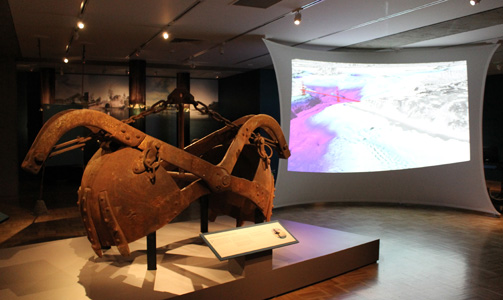Climate change, commerce and transportation, changing populations, recreation, invasive species, and environmentalism are a few of the dynamic themes to be explored in the Oakland Museum of California’s (OMCA) major multi-disciplinary exhibition, Above and Below: Stories From Our Changing Bay, on view now through February 23, 2014.

Clamshell dredges like this one scoop out material from the Bay’s bottom. Much of that material is deposited on the floor of the Bay, depicted in a simulated flyover projected in the exhibition Above and Below: Stories From Our Changing Bay. Image courtesy of Oakland Museum of California.
BC Staff Report
Published: September, 2013
Climate change, commerce and transportation, changing populations, recreation, invasive species, and environmentalism are a few of the dynamic themes to be explored in the Oakland Museum of California’s (OMCA) major multi-disciplinary exhibition, Above and Below: Stories From Our Changing Bay, on view now through February 23, 2014. This special exhibition, on view in the museum’s Great Hall, explores the dynamic stories of how the residents of and visitors to the San Francisco Bay Area have shaped and been shaped by the Bay over the last 6,000 years.
The first major exhibition to be presented with all three of OMCA’s transformed galleries of California Art, History, and Natural Sciences open to the public, this multidisciplinary exhibition highlights historic and contemporary place-based stories about the Bay, and engages viewers in discussions about the Bay’s future. Through an extensive use of media featuring oral histories, community voices, and interactives, the exhibition explores how human engineering and natural forces have come together over time to shape and reshape the land and water around the San Francisco Bay, and how sea-level rise, wetlands restoration, invasive species, and climate change are central topics in determining the future of the Bay.
"We are thrilled to be presenting this major exhibition on the historic occasion of the opening of the new East Span of the San Francisco-Oakland Bay Bridge, and to offer an opportunity for exploration of the history of the bridge in the context of the broad and rich story of the San Francisco Bay," says OMCA Director Lori Fogarty. "This topic is ideal for the Oakland Museum of California as we bring together the natural, cultural and creative histories of the Bay—which has defined this region since human habitation began here."
Exhibition Highlights Include:
• An evocative gallery environment revealing objects, projections, and artifacts about life underneath and above the Bay
• Dramatic high-resolution film taking visitors on a sweeping journey 500 feet above the edge of the Bay
• A "fly-through" of the bottom surface of the Bay, which is not flat
• Science stations where visitors can monitor the health of the Bay, its water, sediments, plants, and animals
• Oral histories and original film footage documenting the construction of the San Francisco-Oakland Bay Bridge opening day festivities in 1936, and the work it took to keep the bridge running over the course of the 20th century
• A 22-foot high, 3D projection of the reconstructed Emeryville Shellmound—an original burial ground of the Native Muwekema Ohlone Tribe—and artifacts recovered from the mound, interpreted by living descendants of the mound builders
• "Bay Futures Lounge" where visitors can discuss current and controversial issues pertaining to the Bay, including sea-level rise, wetlands restoration, invasive species, and climate change, and make choices about the future of the Bay
• Stunning aerial, panoramic photographs of the Bay’s colorful salt ponds, which are becoming one of the world’s top experiments in habitat restoration
• Drawbridge hunting "shack," featuring interactive doors and windows that reveal stories about the history of this now ghost town—abandoned in 1979—in the marshes of the South Bay
• Large-scale digital photo matrix showcasing the surface area of the Bay, which has gotten significantly smaller over time due to human activity, through contemporary imagery and historical maps
• Overview of the history of the Bay’s vast military presence, from World War II to the Cold War, featuring an original Nike missile launch station from Angel Island, and images exploring the complex legacy of these military sites today.
OMCA is located at 1000 Oak Street, at 10th Street, in Oakland and is situated between downtown Oakland and Lake Merritt. Museum admission is $12 general; $9 seniors and students with valid ID, $6 youth ages 9 to 17, and free for members and children 8 and under. OMCA offers onsite underground parking and is conveniently located one block from the Lake Merritt BART station, on the corner of 10th Street and Oak Street. For more information, visit museumca.org.

A section of the Gallery focuses on the ways humans have shaped and shifted the bottom of the Bay, featuring quirky stories like these cannonballs. In the 1860s, soldiers on Alcatraz shot these 15-inch cannonballs towards Angel Island for target practice. Many of them still remain on the floor of the Bay, pushed around by ocean currents or washed up on the shore of Angel Island. Image courtesy of Oakland Museum of California.

